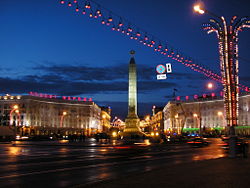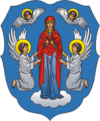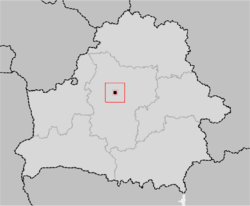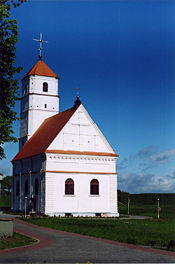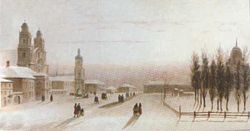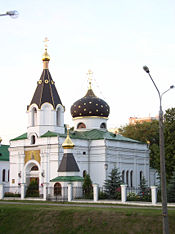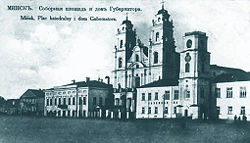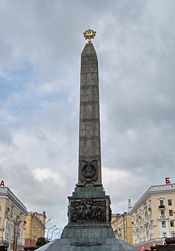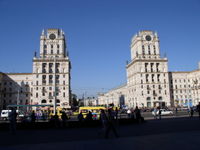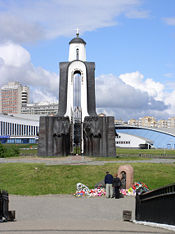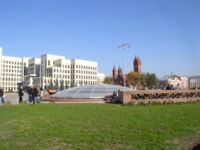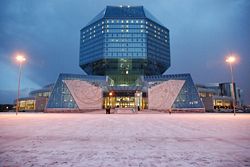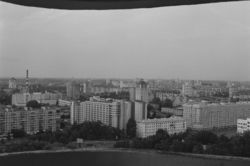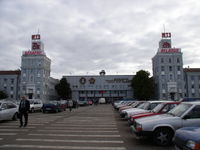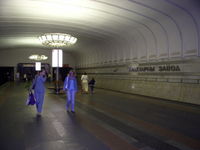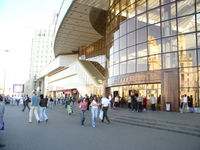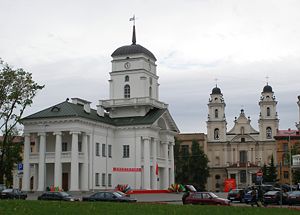Minsk
2008/9 Schools Wikipedia Selection. Related subjects: Europe; European Cities
| Мeнск Minsk |
|||
|
|||
| Location of Minsk, shown within the Minsk Voblast | |||
| Coordinates: | |||
|---|---|---|---|
| Country Subdivision |
Belarus Minsk |
||
| Founded | 1067 | ||
| Government | |||
| - Mayor | Mikhail Pavlov | ||
| Area | |||
| - City | 305.47 km² (117.9 sq mi) | ||
| Elevation | 280.4 m (920 ft) | ||
| Population (2007) | |||
| - City | 1,814,700 | ||
| - Metro | 3,316,700 | ||
| Time zone | EET ( UTC+2) | ||
| - Summer ( DST) | EEST ( UTC+3) | ||
| Area code(s) | +375 17 +375 29 (mobile) |
||
| License plate | 7 | ||
| Website: www.minsk.gov.by | |||
Minsk ( Belarusian: Мінск IPA: [mʲinsk] is the capital and largest city in Belarus, situated on the Svislach and Niamiha rivers. Minsk is also a headquarters of the Commonwealth of Independent States (CIS). As the national capital, Minsk has a special administrative status in Belarus and is also the administrative centre of Minsk voblast ( province) and Minsk raion (district). It has a population of 1,900,000 inhabitants (2008).
The earliest references to Minsk date to the 11th century (1067). In 1242, Minsk became a part of the Grand Duchy of Lithuania, and it received its town privileges in 1499. From 1569, it was a capital of the Minsk Voivodship in the Polish-Lithuanian Commonwealth. It was annexed by Russia in 1793, as a consequence of the Second Partition of Poland. From 1919–1991, Minsk was the capital of the Byelorussian SSR.
Geography and climate
Minsk is located on the southeastern slope of the Minsk Hills, a region of rolling hills running from the southwest (upper reaches of the river Nioman) to the northeast - that is, to the Lukomskaye lake in northwestern Belarus. The average altitude above sea level is 220 m. (721.78 ft.) The geography of Minsk was formed during the two most recent Ice Ages. The Svislach river, which flows across the city from the northwest to the southeast, is located in the urstrohmtal, an ancient river valley formed by water flowing from melting ice sheets at the end of the last Ice Age. Minsk was initially founded on the hills. However, in the 20th century, it grew to include the relatively flat plains in the southeast. The western parts of the city are the most hilly.
Minsk is located in the area of mixed forests typical for most of Belarus. Pinewood and mixed forests are still present at the edge of the city, especially in the north and east. Some of the forests were transformed into parks (for instance, the Chelyuskinites Park) as the city grew.
Minsk has a warm summer humid continental climate (Koppen Dfb), owing to its location between the strong influence of the moist air of the Atlantic Ocean and the dry air of the Eurasian landmass. Its weather is, however, unstable and tends to change often. The average January temperature is -6.1 Celsius (21 °F), while the average July temperature is 17.8 °C (64 °F). The lowest temperature was recorded on 17 January, 1940 (-40 °C) (-40 °F) and the warmest on 29 July, 1936 (35 °C) (95 °F). The air is often moist, with humidity levels at 80-90%, especially during the cold season. There are on average 135 humid days a year, compared with only 6 dry days. This results in frequent fogs, common in the autumn and spring. Minsk receives annual precipitation of 646 mm (25.4 in), of which one third falls during the cold period (as snow and rain) and two thirds in the warm period. Throughout the year, most winds are westerly and northwesterly, bringing cool and moist air from the Atlantic.
| Weather averages for Minsk | |||||||||||||
|---|---|---|---|---|---|---|---|---|---|---|---|---|---|
| Month | Jan | Feb | Mar | Apr | May | Jun | Jul | Aug | Sep | Oct | Nov | Dec | Year |
| Record high °C (°F) | 10.3 (51) | 13.6 (56) | 18.9 (66) | 26.0 (79) | 30.4 (87) | 32.5 (91) | 35.0 (95) | 34.4 (94) | 30.3 (87) | 24.7 (76) | 16.0 (61) | 10.3 (51) | 35.0 (95) |
| Average high °C (°F) | -4.3 (24) | -3.2 (26) | 1.7 (35) | 10.1 (50) | 17.8 (64) | 21.3 (70) | 22.7 (73) | 21.7 (71) | 16.4 (62) | 9.5 (49) | 2.6 (37) | -1.7 (29) | 9.6 (49) |
| Average low °C (°F) | -10.0 (14) | -9.4 (15) | -5.6 (22) | 1.2 (34) | 7.2 (45) | 10.8 (51) | 12.5 (55) | 11.6 (53) | 7.4 (45) | 2.6 (37) | -1.8 (29) | -6.4 (20) | 1.8 (35) |
| Record low °C (°F) | -39.1 (-38) | -35.1 (-31) | -30.5 (-23) | -18.4 (-1) | -5.0 (23) | 0.0 (32) | 3.8 (39) | 1.7 (35) | -4.7 (24) | -12.9 (9) | -20.4 (-5) | -30.6 (-23) | -39.1 (-38) |
| Precipitation mm (inches) | 40 (1.57) | 34 (1.34) | 42 (1.65) | 42 (1.65) | 62 (2.44) | 83 (3.27) | 88 (3.46) | 72 (2.83) | 60 (2.36) | 49 (1.93) | 52 (2.05) | 53 (2.09) | 677 (26.65) |
| Source: Pogoda.ru.net 8.09.2007 | |||||||||||||
History
Early history
The area of today's Minsk was settled by the Early East Slavs by the 9th century. The Svislach River valley was the settlement boundary between two Early East Slavs tribes - the Krivichs and Dregovichs. By 980, the area was incorporated into the early medieval Principality of Polatsk, one of the earliest East Slav states. Minsk was first mentioned in the name form Měneskъ (Мѣнескъ) in the Primary Chronicle for the year 1067 in association with the Battle on the river Nemiga. 1067 is now widely accepted as the founding year of Minsk. City authorities consider the date of September 2, 1067, to be the exact founding date of the city , though the town (by then fortified by wooden walls) had certainly existed for some time by then.
In the early 12th century, the Principality of Polatsk disintegrated into smaller fiefs. The Principality of Minsk was established by one of the Polatsk dynasty princes. In 1129, the Principality of Minsk was annexed by Kiev, the dominant principality of Kievan Rus; however in 1146 the Polatsk dynasty regained control of the principality. By 1150, Minsk rivaled Polatsk as the major city in the former Principality of Polatsk. The princes of Minsk and Polatsk were engaged in years of struggle trying to unite all lands previously under the rule of Polatsk.
Lithuanian and Polish rule
Minsk escaped the Mongol invasion of Rus in 1237-1239. However, in later years it was attacked by nomadic invaders from the Golden Horde, who turned many principalities of disintegrated Kievan Rus into their vassal states. Trying to avoid the Tatar yoke, the Principality of Minsk sought protection from Lithuania from various northern princes, who had been consolidating their power in the region. In 1242, Minsk became a part of the expanding Grand Duchy of Lithuania. It was joined peacefully and local elites enjoyed high rank in the society of the Grand Duchy. In 1413, the Grand Duchy of Lithuania and Kingdom of Poland entered into a union. Minsk became the centre of Minsk Voivodship (province). In 1441, the Lithuanian prince Kazimierz IV Jagiellon included Minsk in a list of cities enjoying certain privileges, and in 1499, during the reign of his son, Aleksander Jagiellon, Minsk received town privileges under Magdeburg law. In 1569, after the Union of Lublin, the Grand Duchy of Lithuania and the Kingdom of Poland merged into a single state, the Polish-Lithuanian Commonwealth. Afterwards, a Polish community including government clerks, officers, and craftsmen settled in Minsk.
By the middle of the 16th century, Minsk was an important economic and cultural centre in the Polish-Lithuanian Commonwealth. It was also an important centre for the Eastern Orthodox Church. Following the Union of Brest, both the Uniate church and the Roman Catholic Church increased in influence.
In 1654, Minsk was conquered by troops of Tsar Alexei of Russia. Russians governed the city until 1667, when it was regained by Jan Kasimir, King of Poland. By the end of the Polish-Russian war, Minsk had only about 2,000 residents and just 300 houses. The second wave of devastation occurred during the Great Northern War, when Minsk was occupied in 1708 and 1709 by the Swedish army of Charles XII and then by the Russian army of Peter the Great. The last decades of the Polish rule involved decline or very slow development, since Minsk had become a small provincial town of little economic or military significance. By 1790, however, it had a population of 6,500-7,000 and was slowly re-expanding to the city limits of 1654. Most of the Minsk residents at the time were Jews and Poles, with a minority of Belarusians.
Russian rule
Minsk was annexed by Russia in 1793 as a consequence of the Second Partition of Poland. In 1796, it became the centre of the Minsk guberniya (province). All of the Polish street names were replaced by Russian, though the spelling of the city's name remained unchanged.
Throughout the 19th century, the city continued to grow and significantly improve. In the 1830s, major streets and squares of Minsk were cobbled and paved. A first public library was opened in 1836, and a fire brigade was put into operation in 1837. In 1838, the first local newspaper, Minskiye gubernskiye vedomosti (“Minsk province news”) went into circulation. The first theatre was established in 1844. By 1860, Minsk was an important trading city with a population of 27,000. There was a construction boom that led to the building of 2 and 3-story brick and stone houses in Upper Town.
Minsk's development was boosted by improvements in transportation. In 1846, the Moscow-Warsaw road was laid though Minsk. In 1871, a railway link between Moscow and Warsaw ran via Minsk, and in 1873, a new railway from Romny in Ukraine to the Baltic Sea port of Libava ( Liepaja) was also constructed. Thus Minsk became an important rail junction and a manufacturing hub. A municipal water supply was introduced in 1872, the telephone in 1890, the horse tram in 1892, and the first power generator in 1894. By 1900, Minsk had 58 factories employing 3,000 workers. The city also boasted theatres, cinemas, newspapers, schools and colleges, as well as numerous monasteries, churches, synagogues, and a mosque. According to the 1897 Russian census, the city had 91,494 inhabitants, with some 47,561 Jews constituting more than half of the city population.
20th century
In the early years of the 20th century, Minsk was a major centre for the worker's movement in Belarus. The 1st Congress of the Russian Social Democratic Labour Party, the forerunner to the Bolshevik and eventually the CPSU, was held there in 1898. It was also one of the major centres of the Belarusian national revival, alongside Vilnia. However, the First World War affected the development of Minsk tremendously. By 1915, Minsk was a battle-front city. Some factories were closed down, and residents began evacuating to the east. Minsk became the headquarters of the Western Front of the Russian army and also housed military hospitals and military supply bases.
The Russian Revolution had an immediate effect in Minsk. A Worker's Soviet was established in Minsk in October of 1917, drawing much of its support from disaffected soldiers and workers. After the Treaty of Brest-Litovsk, German forces occupied Minsk in February of 1918. On 25 March, 1918, Minsk was proclaimed the capital of the Belarusian People's Republic. The republic was short-lived; in December, 1918, Minsk was taken over by the Red Army. In January, 1919 Minsk was proclaimed the capital of the Byelorussian SSR, though later in 1919 (see Operation Minsk) and again in 1920, the city was controlled by the Second Polish Republic during the course of the Polish-Bolshevik war. Under the terms of the Peace of Riga, Minsk was handed back to the Russian SFSR and became the capital of the Byelorussian SSR, one of the founding republics of the Union of Soviet Socialist Republics.
A programme of reconstruction and development was begun in 1922. By 1924, there were 29 factories in operation; schools, museums, theatres, libraries were also established. Throughout the 1920s and the 1930s, Minsk saw rapid development with dozens of new factories being built and new schools, colleges, higher education establishments, hospitals, theatres, and cinemas being opened. During this period, Minsk was also a centre for the development of Belarusian language and culture.
Before World War II, Minsk had had a population of 300,000 people. After Germany invaded the Soviet Union on 22 June, 1941, as part of Operation Barbarossa, Minsk immediately came under attack. The city was bombed on the first day of the invasion and was occupied by the German Army four days later. However, some factories, museums and tens of thousands of civilians had been evacuated to the east. The Germans designated Minsk the administrative centre of Reichskomissariat Ostland and treated the local population harshly. Communists and sympathisers were killed or imprisoned; thousands were forced into slave labour, both locally and after being transported to Germany. Homes were requisitioned to house occupying German forces. Thousands starved as food was seized by the German Army and paid work was scarce. Some residents did support the Germans, especially at the beginning of the occupation, but by 1942, Minsk had become a major centre of the Soviet partisan resistance movement against the occupation, in what is known as the Great Patriotic War. For this role, Minsk was awarded the title Hero City in 1974.
Minsk was, however, the site of one of the largest Nazi-run ghettos in World War II, temporarily housing over 100,000 Jews. (See below for the external link on the Minsk Ghetto).
Minsk was liberated by Soviet troops on 3 July, 1944, during Operation Bagration. The city was the centre of German resistance to the Soviet advance and saw heavy fighting during the first half of 1944. Factories, municipal buildings, power stations, bridges, most roads and 80% of houses were reduced to rubble. In 1944, Minsk's population was reduced to a mere 50,000.
After World War II, Minsk was rebuilt, but not reconstructed. The historical centre was replaced in the 1940s and 1950s by Stalinist architecture, which favoured grand buildings, broad avenues and wide squares. Subsequently, the city grew rapidly as a result of massive industrialisation. Since the 1960s Minsk's population has also grown apace, reaching 1 million in 1972 and 1.5 million in 1986. This rapid population growth was primarily driven by mass migration of young, unskilled workers from rural areas of Belarus, as well as by migration of skilled workers from other parts of the Soviet Union. To house the expanding population, Minsk spread beyond its historical boundaries. Its surrounding villages were absorbed and rebuilt as mikroraions, districts of high-density apartment housing.
Recent developments
Throughout the 1990s, after the fall of Communism, the city continued to change. As the capital of a newly-independent country, Minsk quickly acquired the attributes of a major city. Embassies were opened, and a number of Soviet administrative buildings became government centers. During the early and mid-1990s, Minsk was hit by an economic crisis and many development projects were halted, resulting in high unemployment and underemployment. Since the late 1990s, there have been improvements in transport and infrastructure, and a housing boom has been underway since 2002. On the outskirts of Minsk, new mikroraions of residential development have been built. Metro lines have been extended, and the road system (including the Minsk ring road) has been improved. Owing to the small size of the private sector in Belarus, most development has so far been financed by the government. In January 2008, the city government announced several projects on its official web-site. Among them are the refurbishment of some streets and main avenues, the constructions of more up-to-date hotels (one near the Palace of the Republic and another on the shore of Lake Komsomolkye), the demolition of the out-of-date Belarus hotel and the erection in the same premises of a complex consisting of sport facilities, swimming pool, 2 hotel towers and one business centre building with the help of potential foreign investors and the construction of a modern aquatic park in the outskirts of the city. On September 8, 2007, the city of Minsk celebrated 940 years since its founding.
Etymology and historical names
The Old East Slavic name of the town was Мѣньскъ (i.e. Měnsk < Early Proto-Slavic or Late Indo-European Mēnĭskŭ), derived from a river name Měn (< Mēnŭ, with the same etymology as German Main). The direct continuation of this name in Belarusian is Miensk (pronounced [mʲɛnsk], according to the Łacinka alphabet).
In the 16th and 17th centuries, however, the pronunciation of this name in the Ruthenian language common to the ancestors of Belarusians and Ukrainians was influenced by the pronunciation of *ě as i in many Ukrainian dialects. The resulting form of the name, Minsk (spelled either Минскъ or Мѣнскъ) was taken over both in Russian (modern spelling: Минск) and Polish (Mińsk), and under the influence especially of Russian it also became official in Belarusian. However, some Belarusian-speakers continue to use Miensk (spelled Мeнск) as their preferred name for the city. Another explanation of the origins of the modern form of the name, Minsk, is the strong Ukrainian influence in the Belarusian lexicography in the 1920s, which resulted in the Ukrainian-like i vocalisation of then-deprecated ѣ.
When Belarus was under Polish rule, the names Mińsk Litewski 'Minsk of [the Grand Duchy of] Lithuania' and Mińsk Białoruski 'Minsk in Belarus' were used to differentiate this place name from Mińsk Mazowiecki 'Minsk in Masovia'. In modern Polish, Mińsk without an attribute is Minsk, which is about 50 times bigger than Mińsk Mazowiecki; cf. Brest-Litovsk and Brześć Kujawski for a similar case).
Demographics
Population growth
|
|
* - census
Ethnic groups
During the first centuries of its existence, Minsk was a city with a predominantly Early East Slavic population (the forefathers of modern-day Belarusians). After the 1569 Polish-Lithuanian union, the city became a destination for migrating Poles (who worked as administrators, clergy, teachers and soldiers) and Jews (who were mainly employed in trade and as craftsmen). During the last centuries of the Polish-Lithuanian Commonwealth many locals were polonized and abandoned their Belarusian culture. After the Partitions of Poland, Minsk became part of the Russian Empire, the Russians essentially stepping in to the leadership role enjoyed by the Poles in earlier centuries. By the end of the 19th century Minsk was undergoing increasing russification. Many locals became russified and still claim Russian ethnicity today. The Russians restored the Belarusian culture, a culture very similar to Ukraine and Russia.
At the time of the 1897 census, Jews were the largest ethnic group in Minsk (51.2% of the population). Other substantial ethnic groups were Russians (25.5%), Poles (11.4%) and Belarusians (9%). The latter figure may be not accurate as some local Belarusians were likely to be counted as Russians. There was also a small traditional community of Lipka Tatars living in Minsk for centuries.
Both World War I and World War II affected the demographics of the city. The Jewish community suffered catastrophic losses during the Nazi occupation—very few survived. In the post-war years Minsk's population grew primarily as a result of rural migrants from other parts of Belarus moving to the city.
In 1959 Belarusians made up 63.3% of the city's residents. Other ethnic groups included Russians (22.8%), Jews (7.8%), Ukrainians (3.6%), Poles (1.1%) and Tatars (0.4%). Migration of rural migrants from other parts of Belarus in the 1960s and 1970s changed the ethnic composition further. By 1979 Belarusians made up 68.4% of the city's residents. Other ethnic groups included Russians (22.2%), Jews (3.4%), Ukrainians (3.4%), Poles (1.2%) and Tatars (0.2%).
According to the 1999 census, Belarusians make up 79.3% of the city's residents. Other ethnic groups include Russians (15.7%), Ukrainians (2.4%), Poles (1.1%) and Jews (0.6%). The Russian and Ukrainian populations of Minsk peaked in the late 1980s (at 325,000 and 55,000 respectively). After the break-up of the Soviet Union, many of them chose to move to their respective mother countries. The Jewish population of Minsk peaked in the early 1970s at 50,000 (according to official figures; independent estimates put the figure at 100-120,000), but then declined as a result of emigration to Israel, the USA and Germany. Today there are only about 10,000 Jews living in Minsk. The traditional minorities of Poles and Tatars have remained at much the same size (17,000 and 3,000 respectively). There was migration of rural Poles from the western part of Belarus to Minsk, and many Tatars moved to Minsk from Tatarstan.
Some more recent ethnic minority communities are establishing themselves in the city. The most prominent are migrants from the Caucasus countries— Georgians, Armenians and Azerbaijanis each numbering about 2,000-5,000. They began migrating to Minsk back in the 1970s, and more migrants have joined them since. Many of them are employed in the retail trade in open-air markets. There is also small but prominent Arab community in Minsk, primarily represented by recent migrants from Syria, Lebanon, Egypt, Algeria, etc. (often graduates of Minsk universities who decide to settle in Belarus and their families). There is also a small community of gypsies, numbering about 2,000, which is settled in suburbs of north-western and southern Minsk.
Languages
Throughout its history Minsk has been a city of many languages. Initially most of its residents spoke Ruthenian (which later developed into modern Belarusian). However, after 1569 the official language was Polish. By the end of the 18th century most residents of Minsk were Polish-speakers (or Yiddish-speakers among the Jewish community). Yiddish remained a major language in Minsk until the early 20th century. In the 19th century Russian became the official language and by the end of that century it had become the language of administration, schools and newspapers. The Belarusian national revival increased interest in the Belarusian language—its use has grown since the 1890s, especially among the intelligentsia. In the 1920s and early 1930s Belarusian was major language of Minsk, including for administration and education (both secondary and tertiary). However, since the late 1930s Russian again began gaining dominance. This process accelerated after World War II —by the mid-1980s Minsk was almost exclusively Russian-speaking. A short period of Belarusian national revival in the early 1990s has seen a rise in numbers of Belarusian speakers. However, in 1994 the newly elected president Alexander Lukashenko slowly reversed this trend. Most residents of Minsk now use Russian exclusively in their everyday lives at home and at work, although Belarusian is understood as well. Substantial number of recent migrants from the rural areas uses Trasyanka (Russo-Belarusian pidgin language) in their everyday lives.
The most commonly used and understood international language in Minsk, especially among the younger generation, is English. The second widely spoken international language is German. French, Spanish and Italian are understood by only a few.
Religion
There is no reliable statistics on religious affiliations in Minsk or in Belarus. According to various estimates, between 30% to 50% of Minsk's population do not practice any religion, while being either atheist, agnostic or simply spiritual, but not attached to a particular formal religious institution. Of those Minsk residents who are religious, about 70% consider themselves to be Russian Orthodox, 15-20% - Roman Catholic, and about 5% - Protestants. Most ethnic Russians, Ukrainians and Belarusians from central and eastern parts of Belarus are Russian Orthodox, while Poles and Belarusians from Western Belarus are often Roman Catholic. There are small religious communities of Jews and Muslims (the latter - primarily recent migrants from countries or regions with predominantly Muslim population, such as Azerbaijan, Kazakhstan, Uzbekistan, Turkey, Syria, Iran, Tajikistan, etc). Total number of religious groups registered in Minsk is 116.
Currently there are 24 churches of various denominations, another 10 are being built or reconstructed.
Government and administrative divisions
In 1938 Minsk was divided into smaller administrative units ( raions, or districts) due to rapid population growth. On 17 March 1938 three districts were established:
- Stalinski, i.e., Stalin district, renamed into Zavodzki (Factory/Plant district, after major tractor and automobile plants located there) in 1961
- Varashylauski, i.e., Voroshilov district, renamed into Savetski (Soviet district) in 1961
- Kahanovichski, i.e., Kaganovich district, renamed into Kastrychnitski (October district) in 1957
Districts
There are now 9 administrative districts:
- Frunzenski, named after Mikhail Frunze
- Kastrychnitski, named after October, i.e., October Revolution
- Leninski, named after Lenin
- Maskouski, named after Moscow
- Partyzanski, named after Soviet partisans
- Pershamayski, named after the 1st of May
- Savetski, or " Soviet District"
- Centralny, or "Central District"
- Zavodzki, or "Factory district" (initially it included major plants, Minsk Tractor Works (MTZ) and Minsk Automobile Plant (MAZ), later the Partyzanski District with MAZ was split off it)
Microraions
There are also microraions - bedroom community areas of housing development outside the historical centre. Many of them are named after the suburban villages swallowed by the city.
|
|
Economy
Minsk is the economic capital of Belarus. It has developed industrial and services sectors which serve the needs not only of the city, but of the entire nation.
Industry
Minsk is the major industrial centre of Belarus. The city has over 250 factories and plants. Its industrial development started in the 1860s and was facilitated by the railways built in the 1870s. However, much of the industrial infrastructure was destroyed during World War I and especially during World War II. After the last war the development of the city was linked to the development of industry, especially of R&D-intensive sectors (heavy emphasis of R&D intensive industries in urban development in the USSR is known in Western geography as 'Minsk phenomenon'). Minsk was turned into a major production site for trucks, tractors, gears, optical equipment, refrigerators, television sets and radios, bicycles, motorcycles, watches, and metal-processing equipment. Outside machine-building and electronics, Minsk also had textiles, construction materials, food processing, and printing industries. During the Soviet period, development of the industries was linked to suppliers and markets within the USSR, and the break-up of the union in 1991 led to a serious economic meltdown in 1991-1994. However, since the adoption of the neo-Keynesean policies under Alexander Lukashenko's government in 1995, much of the gross industrial production was regained. Unlike many other cities in the CIS and Eastern Europe Minsk was not heavily de-industrialised in the 1990s. About 40% of the labour force is still employed in the manufacturing sector. Over 70% of produced goods are exported from Belarus, especially to Russia and other members of the Commonwealth of Independent States. However, the recent industrial revival did not lead to updating technologies and equipment (as FDI was discouraged), therefore much of the local industry is not highly competitive by international standards.
Transport and infrastructure
Local Transport
Minsk has an extensive public transport system. Passengers are served by 8 tramway lines, over 70 trolleybus lines, and over 100 bus lines.
Rapid Transit
Minsk is the only city in Belarus with an underground metro system. Construction of the metro began in 1977, soon after the city reached over a million people, and the first line with 8 stations was opened in 1984. Since then it has expanded into two lines: Moskovskaya and Avtozavodskaya, which are 12.2 and 18.1 kilometres long with 11 and 14 stations, respectively. On November 7, 2007, two new stations on the Moskovskaya Line were opened; work continues on a 5.2 km extension, with 3 more stations slated to open in 2011. There are plans for a network with three lines totalling (based on present expansion plans) 58.3 km of track with 45 stations and 3 train depots. For this to happen the third line should cut the city on a north-south axis crossing the existing two and thus forming a typical Soviet triangle layout; construction of the third line is expected to begin in 2011 and for the first stage to be delivered in late 2010s. Some layout plans speculate on a possible fourth line running from Vyasnyanka to Serabranka micro-rayons.
As of 2007 Minsk metro had 25 stations and 33 km. Trains use 223 standard Russian metro-cars. On a typical day Minsk metro is used by 800,000 passengers. During peak hours trains run each 2-2.5 minutes. The metro network employs 3,200 staff.
Currently most of the urban transport is being actively renovated and upgraded to modern standards.
Railway and intercity bus
Minsk is the largest transportation hub in Belarus. It is located on the junction of Warsaw-Moscow railway (built in 1871) running from the south-west to the north-east of the city and Liepaja- Romny railway (built in 1873) running from the north-west to the south. The first railway connects Russia with Poland and Germany, the second connects Ukraine with Lithuania and Latvia. They cross at the Minsk-Passazhyrski railway station, main railway station of Minsk. The station was built in 1873 as Vilenski vakzal. The initial wooden building was demolished in 1890 and rebuilt in stone. During World War II Minsk railway station was completely destroyed. It was rebuilt in 1945-1946 and served until 1991. The new building of Minsk-Passazhyrski railway station was built in 1991-2002. Its construction was delayed due to financial difficulties. However now Minsk boasts one of the most modern and up-to-date railway stations in the CIS. There are plans to move all suburban rail traffic from Minsk-Passazhyrski to smaller stations Minsk- Uskhodni (East), Minsk-Paudnyovy (South) and Minsk-Paunochny (North) by 2020.
There are three intercity bus stations, linking Minsk with suburbs, other cities in Belarus and in the neighbouring countries. Frequent schedules bus routes connect it to Moscow, Vilnius, Riga, Kiev and Warsaw.
Airports
Minsk International Airport is located 42 km to the east of the city. It opened in 1982 (passenger terminal - in 1987.) It is an international airport undergoing modernisation with flights to Austria, Cyprus, France, Germany, Ireland, Israel, Italy, Iran, Latvia, Poland, Russia, Turkey, United Kingdom, and other countries, operated by the national carrier Belavia and the German airline Lufthansa, AirBaltic of Latvia, as well as Austrian airline Austrian Airlines Group.
Minsk-1 opened in 1933 a few kilometres to the south of the historical centre. In 1955 it became an international airport and by 1970 served over 1 million passengers a year. From 1982 it mainly served domestic routes in Belarus and short-haul routes to Moscow, Kiev and Kaliningrad. Minsk-1 is expected to be closed in 2008 because of the noise pollution in the surrounding residential areas. The land of the airport will be re-developed for residential and commercial real estate, currently branded as Minsk-City.
Education
Minsk is the major educational centre of Belarus. It has over 500 nursery schools, 258 schools, 28 further education colleges, and 36 higher education institutions, including 12 major national universities (most specialising in certain areas of science and technology).
Major universities
- Belarusian State University. Major Belarusian universal university, founded in 1921. In 2006 had 15 major departments (Applied Mathematics and Infoscience; Biology; Chemistry; Geography; Economics; International Relations; Journalism; History; Humanitarian Sciences; Law; Mechanics and Mathematics; Philology; Philosophy and Social Sciences; Physics; Radiophysics and Electronics). It also included 5 R&D institutes, 24 Research Centres, 114 R&D laboratories. The University employs over 2,400 lecturers and 1,000 research fellows; 1,900 of these hold Ph.D. or Dr. Sc. degrees. There are 16,000 undergraduate students at the university, as well as over 700 Ph.D. students.
- Belarusian State University of Agricultural Technology. Specialised in agricultural technology and agricultural machinery.
- Belarusian National Technical University. Specialised in technical disciplines.
- Belarusian State Medical University. Specialised in Medicine and Dentistry. Since 1921 - Medicine Department of the Belarusian State University. In 1930 becomes separate as Belarusian Medical Institute. In 2000 upgraded to university level. Currently has 6 departments.
- Belarusian State Economic University. Specialised in Finance and Economics. Founded in 1933 as Belarusian Institute for National Economy. Upgraded to university level in 1992.
- Belarusian State University of Culture and Arts. Specialised in cultural studies, visual and performing arts.
- Maxim Tank Belarusian State Pedagogical University. Specialised in teacher training for secondary schools.
- Belarusian State University of Informatics and Radioelectronics. Specialised in IT and radioelectronic technologies. Established in 1964 as Minsk Institute for Radioelectronics.
- Belarusian State University of Physical Training. Specialised in sports, coaches and PT teachers training.
- Belarusian State Technological University. Specialised in chemical and pharmaceutical technology, in printing and forestry. Founded in 1930 as Forestry Institute in Homel. In 1941 evacuated to Sverdlovsk, now Yekaterinburg. Returned to Gomel in 1944, but in 1946 relocated to Minsk as Belarusian Institute of Technology. Upgraded to university level in 1993. Currently has 9 departments.
- Minsk State Linguistic University. Specialised in foreign languages. Founded in 1948 as Minsk Institute for Foreign Languages. In 2006 had 8 departments. Major focus on English, French, German and Spanish.
- Andrei Sakharov International State Environmental University. Specialised in environmental sciences. Established in 1992 with the support from the United Nations. Focus on study and research of radio-ecological consequences of the Chernobyl nuclear power station disaster in 1986, which heavily affected Belarus.
Culture and religion
Minsk is the major cultural centre of Belarus. Its first theatres and libraries were established in the middle of the 19th century. Now it has 11 theatres and 16 museums. There are 20 cinemas and 139 libraries.
Churches
- The Orthodox Cathedral of the Holy Spirit is actually the former church of the Bernardine convent. It was built in the simplified Baroque style in 1642-87 and went through renovations in 1741-46 and 1869.
- The Cathedral of Saint Virgin Mary was built by the Jesuits as their monastery church in 1700-10, restored in 1951 and 1997; it overlooks the recently restored 18th-century city hall, located on the other side of the Independence Square;
- Two other historic churches are the cathedral of St. Joseph, formerly affiliated with the Bernardine monastery, built in 1644-52 and repaired in 1983, and the fortified church of Sts. Peter and Paul, originally built in the 1620s and recently restored, complete with its flanking twin towers.
- The impressive Neo-Romanesque Roman Catholic Red Church (Cathedral of Sts. Simeon and Helene) was built in 1906-10, immediately after religious freedoms were proclaimed in Imperial Russia and the tsar allowed dissidents to build their churches;
- The largest church built in the Russian imperial period of the town's history is dedicated to St. Mary Magdalene;
- Many Orthodox churches were built after the dissolution of the USSR in a variety of styles, although most remain true to the Neo-Russian idiom. A good example is St. Elisabeth's Convent, founded in 1999.
Theatres
Major theatres are:
- National Academic Big Opera and Ballet Theatre of the Republic of Belarus
- Belarusian Musical Comedy Theatre
- Maxim Gorky National Drama Theatre (performances in Russian)
- Yanka Kupala National Drama Theatre (performances in Belarusian)
Museums
Major museums include:
- Belarusian Great Patriotic War Museum
- Belarusian National Arts Museum
- Belarusian National History and Culture Museum
- Belarusian Nature and Environment Museum
- Ethnography and Folklore Museum
- Maksim Bahdanovich Literary Museum
- Old Belarusian History Museum
- Yanka Kupala Literary Museum
Recreation areas
- Chelyuskinites Park
- Children's Railroad
- Gorky Park (Minsk)
- Forest Park
- Yanka Kupala Park
Sport
- FC Dinamo Minsk
- FC MTZ-RIPO
- FC Minsk
- FC Lokomotiv Minsk
- HC Dinamo Minsk
- HC Junost Minsk
- HC Keramin Minsk
The Strategic Plan of Minsk Development by the Year 2020
The latest research of many scientific centers proved that the tendency towards the transfer to large cities and metropolises of the key efforts aimed at improving living standards and environment, increasing the competitive potential of economy and struggle for outlets will prevail in the 21st century. The globalization process will facilitate the creation of global cities, the centers managing the world economy, financial markets and science intensive productions. These tendencies prompted the necessity to elaborate the concept and strategic plan of a sustainable development of the city of Minsk by 2020.
The Minsk development concept fits in the formula ”Five cities in one”. The first component of the concept is “The city of health and high social standards”. It means the top priority of the sci-tech and socio-economic progress in Belarus’ capital city is not the development of production or technological values, but the Human Being and his/her physical and spiritual health in a safe and favorable environment. The following conditions are to be met to ensure this component: “clean water”, “clean air”, “warmth in houses”, “good nutrition”, etc.
The second part of the concept – “The city of knowledge and science intensive technologies” – includes the development of the educational, science-innovation complex, creation of a state-of-the-art information structure, restructuring of the industrial complex, technological upgrade of construction and power engineering and encouragement of foreign economic activity.
The third basis of the sustainable development of the city of Minsk is “The city is the centre of international communication”. It envisages further development of external transport functions, the culture component, tourism, and city media. Besides the economic benefit the communication progress results in a huge advantage for international and human communication in the modern integrated world.
The fourth strategy of Minsk’s sustainable development - “The city favorable for business and attractive for investments” – envisages the creation of such conditions as a favorable tax climate, land relations that correspond to market relations and establishment of the real estate market.
The fifth component of the Minsk development concept is “The city developing democracy with a wide representation of citizens”. It aims at elaborating the rules of living in the city, methods of city administration and the interaction between the city authorities, population, companies and organizations, as well as ways to effectively perform the functions of the capital of the country.
“Sustainable development of the city” is not a new tag for old ideas, but a completely new approach directed towards the next generation. Sustainable development is necessary not only for regional, but also for global development, because the ultimate goal is to coordinate the interests of generations, develop social cooperation, improve living standards and become more responsible on a global scale.
Twin cities
As of 2008 Minsk maintains cultural links to 14 twin towns in various countries :
 Nottingham, UK (since 1957)
Nottingham, UK (since 1957) Sendai, Japan (since 1973)
Sendai, Japan (since 1973) Bangalore, India (since 1973)
Bangalore, India (since 1973) Lyon, France (since 1976)
Lyon, France (since 1976) Changchun, People's Republic of China (since 1992)
Changchun, People's Republic of China (since 1992) Lodz, Poland (since 1992)
Lodz, Poland (since 1992) Bonn, Germany (since 1993)
Bonn, Germany (since 1993) Eindhoven, Netherlands (since 1994)
Eindhoven, Netherlands (since 1994) Dushanbe, Tajikistan (since 1998)
Dushanbe, Tajikistan (since 1998) Kishinev, Moldova (since 2000)
Kishinev, Moldova (since 2000) Havana, Cuba (since 2005)
Havana, Cuba (since 2005) Tehran, Iran (since 2006)
Tehran, Iran (since 2006) Abu Dhabi, UAE (since 2007)
Abu Dhabi, UAE (since 2007) Ankara, Turkey (since 2007)
Ankara, Turkey (since 2007) Caracas, Venezuela
Caracas, Venezuela
Furthermore partnership agreements with 17 towns and regions from Russia are signed alongside of many Baltic and CIS cities..
Honours
A minor planet 3012 Minsk discovered by Soviet astronomer Nikolai Stepanovich Chernykh in 1979 is named after the city.
